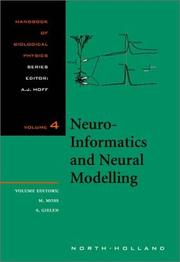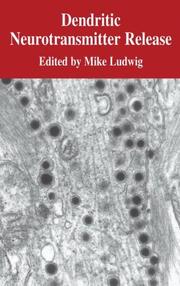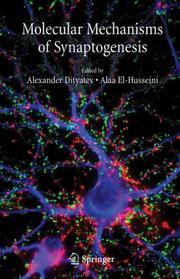| Listing 1 - 10 of 30 | << page >> |
Sort by
|
Book
ISBN: 2040004793 9782040004798 Year: 1974 Publisher: Paris : Gauthier-Villars,
Abstract | Keywords | Export | Availability | Bookmark
 Loading...
Loading...Choose an application
- Reference Manager
- EndNote
- RefWorks (Direct export to RefWorks)
Neural transmission --- Transmission nerveuse --- History --- Histoire --- -Nerve transmission --- Nervous transmission --- Neurotransmission --- Synaptic transmission --- Transmission of nerve impulses --- Neural circuitry --- Neurophysiology --- Neurotransmitters --- Neural transmission. --- Biographies --- History. --- -History --- Biographies. --- Nerve transmission --- Neural transmission - History --- Nerve impulses(Chemical Transmission)history --- Systeme nerveux --- Biochimie

ISBN: 9780444502841 044450284X 9780080537429 0080537421 9786611038717 1281038717 Year: 2001 Publisher: London : Elsevier,
Abstract | Keywords | Export | Availability | Bookmark
 Loading...
Loading...Choose an application
- Reference Manager
- EndNote
- RefWorks (Direct export to RefWorks)
How do sensory neurons transmit information about environmental stimuli to the central nervous system? How do networks of neurons in the CNS decode that information, thus leading to perception and consciousness? These questions are among the oldest in neuroscience. Quite recently, new approaches to exploration of these questions have arisen, often from interdisciplinary approaches combining traditional computational neuroscience with dynamical systems theory, including nonlinear dynamics and stochastic processes. In this volume in two sections a selection of contributions about these topics fr
Neural transmission. --- Neural networks (Neurobiology) --- Cognitive neuroscience --- Neurobiology --- Neural circuitry --- Biological neural networks --- Nets, Neural (Neurobiology) --- Networks, Neural (Neurobiology) --- Neural nets (Neurobiology) --- Neurophysiology --- Neurotransmitters --- Nerve transmission --- Nervous transmission --- Neurotransmission --- Synaptic transmission --- Transmission of nerve impulses

ISBN: 1281043974 9786611043971 0387236961 0387229337 1461498384 Year: 2005 Publisher: New York, NY : Springer US : Imprint: Springer,
Abstract | Keywords | Export | Availability | Bookmark
 Loading...
Loading...Choose an application
- Reference Manager
- EndNote
- RefWorks (Direct export to RefWorks)
The transmission of the nervous impulse is always from the dendritic branches and the cell body to the axon or functional process. Every neuron, then, possesses a receptor apparatus, the body and the dendritic prolongations, an apparatus of emission, the axon, and the apparatus of distribution, the terminal arborization of the nerve fibers. I designated the foregoing principle: the theory of dynamic polarization (Cajal 1923). Ever since the beautiful drawings from Golgi and Cajal, we have been familiar with the organisation of neurones into dendritic, somatic and axonal compartments. Cajal proposed that these cellular compartments were specialised, resulting in his concept of ^dynamic polarisation'. He considered dendrites to be passive elements that simply transferred information from inputs to the soma. Since the discovery that dendrites of many neural populations release neuroactive substances and in doing so, alter neuronal output, it is now apparent that this theory requires qualification. This book presents recent developments in the neurophysiology of dendritic release of several chemical classes of transmitters in a number of different areas of the mammalian central nervous system. Once released from a neuron, these substances can act as neurotransmitters and/or neuromodulators, to autoregulate the original neuron, its synaptic inputs, and adjacent cells or, by volume transmission, to affect distant cells. In some systems, dendritic transmitter release is part independent of secretion from axon terminal signifying a selective control of the dendritic compartment.
Neural transmission. --- Dendrites. --- Neurotransmitters. --- Nerve transmission --- Nervous transmission --- Neurotransmission --- Synaptic transmission --- Transmission of nerve impulses --- Neural circuitry --- Neurophysiology --- Neurotransmitters --- Chemical nerve transmitters --- Nerve transmitter substances --- Neural transmitters --- Neurohumors --- Neuroregulators --- Synaptic transmitters --- Transmitters, Chemical nerve --- Transmitters, Synaptic --- Neurochemistry --- Neural transmission --- Neurons --- Neurosciences. --- Neural sciences --- Neurological sciences --- Neuroscience --- Medical sciences --- Nervous system

ISBN: 1280716282 9786610716289 038732562X 0387325603 Year: 2006 Publisher: New York, NY : Springer US : Imprint: Springer,
Abstract | Keywords | Export | Availability | Bookmark
 Loading...
Loading...Choose an application
- Reference Manager
- EndNote
- RefWorks (Direct export to RefWorks)
Molecular Mechanisms of Synaptogenesis is a compilation of recent exciting findings that summarizes the ever-expanding knowledge of how neuronal contacts develop in the normal brain and how their functions are affected in mental disorders. In the last decade, advances in molecular and cellular biology, combined with the development of sophisticated fluorescence microscopy tools to visualize synapses in live neurons, have revealed many intriguing and unexpected findings regarding the dynamics of synapse formation. Studies by a number of researchers have identified several critical protein components of synapses and shown the time course of their arrival at the synapse. Several molecules serve to hold the synaptic contacts between nerve cells and regulate their function. Imbalance in synaptic contact formation and function has been linked to psychiatric disorders such as schizophrenia, autism and mental retardation. The recent advances in basic research, summarized in Molecular Mechanisms of Synaptogenesis, may lay the necessary scientific groundwork to develop treatments targeting synaptogenesis, allowing us to improve the lives of people affected by brain disorders. This book will be an invaluable resource for neurobiologists taking their first steps in the expanding and exciting field of synaptogenesis.
Neural transmission. --- Synapses. --- Neurotransmitters. --- Cytoskeletal proteins. --- Presynaptic receptors. --- Neurotransmitter receptors --- Structural proteins --- Proteins --- Chemical nerve transmitters --- Nerve transmitter substances --- Neural transmitters --- Neurohumors --- Neuroregulators --- Synaptic transmitters --- Transmitters, Chemical nerve --- Transmitters, Synaptic --- Neurochemistry --- Neural transmission --- Nerve endings --- Nerves --- Neural circuitry --- Synaptosomes --- Nerve transmission --- Nervous transmission --- Neurotransmission --- Synaptic transmission --- Transmission of nerve impulses --- Neurophysiology --- Neurotransmitters --- Neurosciences. --- Neural sciences --- Neurological sciences --- Neuroscience --- Medical sciences --- Nervous system
Book
ISBN: 1281512494 9786611512491 0387772324 0387772316 Year: 2008 Publisher: New York : Springer,
Abstract | Keywords | Export | Availability | Bookmark
 Loading...
Loading...Choose an application
- Reference Manager
- EndNote
- RefWorks (Direct export to RefWorks)
Synapses play a central role in the brain by mediating signal transmission between neurons. This book provides a fundamental description of the synapse by leading experts in the field. Each individual synapse carries out its numerous functions in a tiny space, thereby requiring an exquisite molecular and functional arrangement. This book describes the molecular structure and cellular function of central synapses in the brain, providing a detailed view of the brain’s fundamental unit of information storage.
Neural transmission. --- Synapses. --- Nerve endings --- Nerves --- Neural circuitry --- Neural transmission --- Synaptosomes --- Nerve transmission --- Nervous transmission --- Neurotransmission --- Synaptic transmission --- Transmission of nerve impulses --- Neurophysiology --- Neurotransmitters --- Neurosciences. --- Neurobiology. --- Neurology. --- Medicine --- Nervous system --- Neuropsychiatry --- Neurosciences --- Neural sciences --- Neurological sciences --- Neuroscience --- Medical sciences --- Diseases --- Neurology .

ISBN: 0444801057 9786611716097 128171609X 0080861741 Year: 1980 Volume: vol. 49 Publisher: Amsterdam Elsevier
Abstract | Keywords | Export | Availability | Bookmark
 Loading...
Loading...Choose an application
- Reference Manager
- EndNote
- RefWorks (Direct export to RefWorks)
Acetylcholine --- -Myasthenia gravis --- -Neural Transmission --- -Synapses --- -Nerve endings --- Nerves --- Neural circuitry --- Neural transmission --- Synaptosomes --- Nerve transmission --- Nervous transmission --- Neurotransmission --- Synaptic transmission --- Transmission of nerve impulses --- Neurophysiology --- Neurotransmitters --- Neuromuscular diseases --- Choline --- Cholinergic mechanisms --- Receptors --- -Congresses --- Congresses --- congresses --- Animal psychology and neurophysiology --- Neuropathology --- Pharmacology. Therapy --- Transmission nerveuse --- Congresses. --- Congrès --- -Receptors

ISBN: 0890044228 Year: 1980 Publisher: New York Raven
Abstract | Keywords | Export | Availability | Bookmark
 Loading...
Loading...Choose an application
- Reference Manager
- EndNote
- RefWorks (Direct export to RefWorks)
Animal psychology and neurophysiology --- Nervous System --- Neural transmission --- Information theory in biology --- Neural circuitry --- Transmission nerveuse --- Théorie de l'information en biologie --- Réseaux nerveux --- physiology --- Nervous System Physiological Phenomena. --- Théorie de l'information en biologie --- Réseaux nerveux --- Neural networks (Neurobiology) --- Nerve transmission --- Nervous transmission --- Neurotransmission --- Synaptic transmission --- Transmission of nerve impulses --- Neurophysiology --- Neurotransmitters --- Biological neural networks --- Nets, Neural (Neurobiology) --- Networks, Neural (Neurobiology) --- Neural nets (Neurobiology) --- Cognitive neuroscience --- Neurobiology --- Biology --- Biomathematics
Book
ISBN: 0060467371 Year: 1973 Publisher: New York (N.Y.): Harper and Row
Abstract | Keywords | Export | Availability | Bookmark
 Loading...
Loading...Choose an application
- Reference Manager
- EndNote
- RefWorks (Direct export to RefWorks)
Psychophysiology --- Sensation --- Senses and sensation --- Neural transmission --- Psychobiology --- Sens et sensations --- Transmission nerveuse --- Psychobiologie --- physiology --- 159.93 --- 159.91 --- Sensory biology --- Sensory systems --- Knowledge, Theory of --- Neurophysiology --- Perception --- Biological psychology --- Biopsychology --- Biology --- Human behavior --- Psychology --- Biological psychiatry --- Nerve transmission --- Nervous transmission --- Neurotransmission --- Synaptic transmission --- Transmission of nerve impulses --- Neural circuitry --- Neurotransmitters --- Zintuiglijke waarnemingen --- Psychofysiologie. Neuropsychologie. Psychomotoriek. Psychomotorische therapie --- Neural transmission. --- Psychobiology. --- Senses and sensation. --- 159.91 Psychofysiologie. Neuropsychologie. Psychomotoriek. Psychomotorische therapie --- 159.93 Zintuiglijke waarnemingen --- Psychophysiology. --- physiology.
Book
ISBN: 1281134082 9786611134082 0387736093 0387736085 144194463X Year: 2008 Publisher: New York, NY : Springer US : Imprint: Springer,
Abstract | Keywords | Export | Availability | Bookmark
 Loading...
Loading...Choose an application
- Reference Manager
- EndNote
- RefWorks (Direct export to RefWorks)
Regulation of gene transcription by neuronal activity is evident in a large number of neuronal processes ranging from neural development and refinement of neuronal connections to learning and response to injury. In the field of activity-dependent gene expression, rapid progress is being made that can impact these, and many other areas of neuroscience. The major aim of Transcriptional Regulation by Neuronal Activity: To the Nucleus and Back is to illustrate key advances in the field – specifically how signals are transmitted to the nucleus in response to neuronal activity, what genes are activated and how this is achieved, and how these changes in gene expression alter neuronal function. About the Author: Serena M. Dudek, Ph.D. is best known for her seminal work describing Long-term synaptic Depression (LTD) in the hippocampus. Dr. Dudek heads the Synaptic and Developmental Plasticity Group at the National Institute of Environmental Health Sciences, where her laboratory studies the cellular mechanisms of synaptic plasticity in the adult and developing mammalian brain. Although once a critic of the proposed necessity of transcription for maintenance of synaptic plasticity, Dr. Dudek now devotes much of her time to work on the topic.
Genetic transcription --- Neural transmission. --- Neuroplasticity. --- Regulation. --- Nervous system plasticity --- Neural adaptation --- Neural plasticity --- Neuronal adaptation --- Neuronal plasticity --- Plasticity, Nervous system --- Soft-wired nervous system --- Synaptic plasticity --- Nerve transmission --- Nervous transmission --- Neurotransmission --- Synaptic transmission --- Transmission of nerve impulses --- Medicine. --- Neurosciences. --- Neurology. --- Neurobiology. --- Biomedicine. --- Adaptation (Physiology) --- Neurophysiology --- Developmental neurobiology --- Neural circuitry --- Neurotransmitters --- Genetic regulation --- Neurosciences --- Medicine --- Nervous system --- Neuropsychiatry --- Neural sciences --- Neurological sciences --- Neuroscience --- Medical sciences --- Diseases --- Neurology .

ISBN: 0849318912 9786610604975 1280604972 0203486285 0429095791 Year: 2006 Publisher: Boca Raton, Fla. : CRC/Taylor & Francis,
Abstract | Keywords | Export | Availability | Bookmark
 Loading...
Loading...Choose an application
- Reference Manager
- EndNote
- RefWorks (Direct export to RefWorks)
Exploring the diverse tools and technologies used to study synaptic processes, The Dynamic Synapse: Molecular Methods in Ionotropic Receptor Biology delineates techniques, methods, and conceptual advances for studying neurotransmitter receptors and other synaptic proteins. It describes a broad range of molecular, biochemical, imaging, and electrophysiological approaches for studying the biology of synapses. Specific topics include the use of proteomics to study synaptic protein complexes, the development of phosphorylation state specific antibodies, post-genomic tool
Synapses. --- Neuroplasticity. --- Neural transmission. --- Neurotransmitters. --- Chemical nerve transmitters --- Nerve transmitter substances --- Neural transmitters --- Neurohumors --- Neuroregulators --- Synaptic transmitters --- Transmitters, Chemical nerve --- Transmitters, Synaptic --- Nerve transmission --- Nervous transmission --- Neurotransmission --- Synaptic transmission --- Transmission of nerve impulses --- Nervous system plasticity --- Neural adaptation --- Neural plasticity --- Neuronal adaptation --- Neuronal plasticity --- Plasticity, Nervous system --- Soft-wired nervous system --- Synaptic plasticity --- Neurochemistry --- Neural transmission --- Neural circuitry --- Neurophysiology --- Neurotransmitters --- Adaptation (Physiology) --- Developmental neurobiology --- Nerve endings --- Nerves --- Synaptosomes
| Listing 1 - 10 of 30 | << page >> |
Sort by
|

 Search
Search Feedback
Feedback About
About Help
Help News
News